by Daniela Enriquez
One of the obstacles Orthodox women face is finding a good “kosher” fashion line, that is wearable and respectful of tradition. Designer Marina Rahlin is easing the sartorial woes of Orthodox women with MaRa, her line of Orthodox-friendly fashion. Rahlin was born in the Ukraine, and made aliyah with her family when she was four years old. She now lives in Los Angeles, where the new line has been released.
Below is a lightly edited transcript of the conversation I had with Rahlin about her life, her love for Pop art and her new line.
When and why did you decide to create MaRa?
 I started my first line, Popavina, after attending a school for fashion designers in Los Angeles. Later on I met my fiancé, whose family is religious: his father, his brother and his sisters are all Orthodox Jews. I met with other religious women and they all told me the same thing: how difficult and challenging it is to wear beautiful clothing and be modest. Whatever they saw in fashion shops was beautiful although not appropriate: the sleeves weren’t long enough, the skirts’ length was too short. So I thought, “There has to be a way to create something fashionable and modest.” I came up with the idea of creating dresses that could cover elbows and knees, and whose length avoids the need to wear an undershirt or a petticoat.
I started my first line, Popavina, after attending a school for fashion designers in Los Angeles. Later on I met my fiancé, whose family is religious: his father, his brother and his sisters are all Orthodox Jews. I met with other religious women and they all told me the same thing: how difficult and challenging it is to wear beautiful clothing and be modest. Whatever they saw in fashion shops was beautiful although not appropriate: the sleeves weren’t long enough, the skirts’ length was too short. So I thought, “There has to be a way to create something fashionable and modest.” I came up with the idea of creating dresses that could cover elbows and knees, and whose length avoids the need to wear an undershirt or a petticoat.
Was it difficult to combine old fashion rules with new ideas?
Yes, it is challenging. Sometimes people are not so open to or interested in new ideas and things. I always have to keep in mind religious girls’ point of view. [Venturing] into Orthodox fashion is risky, so whatever I create has to be a little bit classic even if the color is bright pink. I don’t want to invent something too crazy–I know they want to wear my clothing to go to shul. Thus, the items must be wearable for that occasion, too! I have to think about these restrictions.
What kind of materials do you use?
I usually use cotton, linen, and silk–for me it’s important that the dresses are comfortable. Orthodox women are often pregnant and need to wear something without being worried about their belly or back. That’s why I use a lot of stretch fabrics.
Even if your line is totally “kosher,” it’s innovative. Do you think this could scare Orthodox women who are used to dressing in black and white?
Young girls are really open to new colors and changes. They are sick of dead colors and want to look attractive. Everybody wants to look attractive, everybody wants to wear colors that match the skin. As I said, young Orthodox girls are ready for that–they look for ways to look beautiful but appropriate. One way is wearing a lot of jewelry, because that is not incompatible with modesty. Those girls are very happy with my new line and they give me very good feedback.
Tell us about your first collection, Popavina.
Popavina dresses are meant for cocktail parties. I founded it because when I went to events I couldn’t find dresses that weren’t overly sexy. I like clothing that is cute and feminine, inspired by the 1950s, and I couldn’t find anything like that at that time. Thus, I decided to create this line of very cute and feminine dresses, with bows and bright colors.
Popavina takes its name from Pop art. When did your love for this art start?
When I was a kid, I used to go with my parents to museums and Pop art was my favorite painting style. My mother understood my love for it and started buying me books about Roy Lichtenstein, Andy Warhol and Keith Haring. I became more and more interested in them—Frida Kahlo and other artists. My parents really encouraged my love for Pop Art and for whatever else I was interested in as a kid.
Is there something of your love for Pop art in MaRa?
Yes, the bright colors and the particular patterns and details that I use are elements of my style. I try to use in everything I do. They represent me and what I am. You will never see me wearing black. It’s not part of my personality.
Ukraine, Israel and the United States: Which one of these countries influenced you the most?
When somebody asks me if I feel Ukrainian or Israeli or American, I always answer that I feel Jewish. Even if I am not religious, Jewish is what I feel. Design-wise, I would say that I feel Ukrainian, because I see Ukraine as home. Russians and Ukrainians love colors, and I think I got my love for colors from this part of my life and family.
Would you recommend MaRa to non-Orthodox women?
I think so. It’s not just Orthodox women who are interested in my new “modest” line. Mormon women like my dresses, too. Any woman who loves elegance, and doesn’t want to show too much of her body likes my line. It’s stylish without being weird: I want women to be beautiful and modest.
